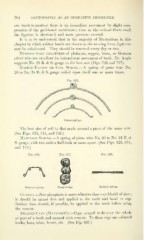Page 706 - My FlipBook
P. 706
704 ORTHODONTIA AS AN OPERATIVE PROCEDURE.
one tooth to auother there is an immediate movement by slight com-
pression of the peridental membrane ; then as the twisted fibers swell
the ligature is shortened and more ])ressure exerted.
It is to be understood that in the majority of illustrations in this
chapter in which rubber bands are shown as the moving force, ligatures
may be substituted. Tliey should be renewed every day or two.
Twisted avire ligatures of platinum, copper, brass, or German
silver wire are excellent for intermittent movement of teeth. Dr. Angle
suggests No. 28 B. & S. gauge as the best size (Figs. 726 and 727).
Norton-Talbot or Coil Spring.—A spring of piano wire No.
20 to No. 24 B. & S. gauge coiled upon itself one or more times.
Ftg. G25.
Talbot springs.
The best size of coil is that made around a piece of the same wire,
(See Figs. 625, 741, and 742.)
Matteson Spring.—A spring of piano wire No. 20 to No. 24 B. &
S. gauge, Avith two coils a half-inch or more apart. (See Figs. 626, 651,
and 744.)
Fig. 626. 627. Fig. 628.
Matteson spring. Swaged caps. Metallic tubing.
Cement.—Zinc phosphate is more adhesive than oxychlorid of zinc ;
it should be mixed thin and applied to the tooth and band or cap.
Rubber dam should, if possible, be applied to the teeth before using
the cement.
Swaged Caps (Matteson's).—Caps swaged to fit over the whole
or part of a tooth and secured with cement. To tliese caps are soldered
hooks, bars, tubes, levers, etc. (See Fig. 627.)


